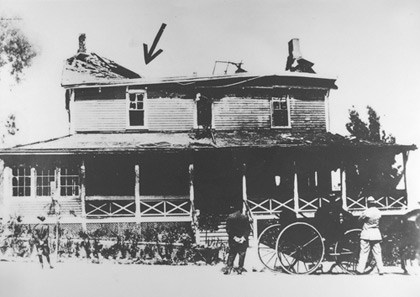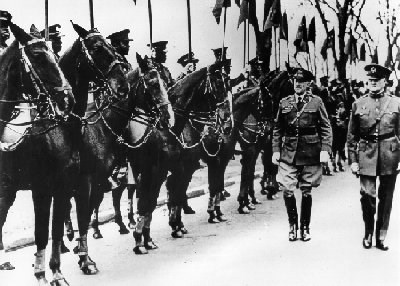Last updated: January 25, 2022
Person
John Pershing

Library of Congress
The foremost military leader of his time, John J. "Black Jack" Pershing (1860-1948) served the United States in the Indian Wars, the Spanish-American War, the Philippines, the Mexican Intervention, and the First World War. Pershing's leadership, organizational skills, and dedication to his missions, his men, and his country led to exceptional success in a wide variety of conflicts.
The Early Years
Pershing was born *September 13, 1860, in Laclede, Missouri, where his pro-Union father managed a general store.
The family survived the Civil War but was financially ruined in the depression of 1873. Young John worked on the family farm and, at age seventeen, began teaching at the local African American school.
He enrolled in the State Normal School in Kirksville, Missouri in 1879 and received his degree in Scientific Didactics.
Pershing initially wanted to be a lawyer, but he passed the United States Military Academy's comptetive admission exam. Though Pershing had never considered military life prior to his admission, he was attracted by the prospect of getting a first-rate education. Pershing entered West Point in 1882. Though Cadet Pershing's grades were average, his age and experience made him a natural leader.
Following his graduation in 1886, Pershing was assigned to the Sixth Cavalry Regiment on the Great Plains, where he fought in a series of Indian campaigns in New Mexico, Nebraska, and South Dakota and quickly gained recognition as a tough, competent officer.
In 1891, Lieutenant Pershing accepted a position at the University of Nebraska as Professor of Military Science and Tactics. Over the course of four years, he revitalized the once-deficient military department.
Pershing’s next assignment was in Montana, where he led the Buffalo Soldiers of the Tenth Cavalry. Around this time, Pershing acquired the nickname "Black Jack”.
Pershing was back teaching at West Point in when the Spanish-American War erupted in 1898. Lieutenant Pershing returned to the 10th Cavalry. The unit was sent to Cuba, where Pershing led his troops in the assault on San Juan Hill. Though the troopers of the 10th took heavy casualties, they served with distinction alongside Lieutenant Colonel Theodore Roosevelt's "Rough Riders". Pershing received the Silver Star for heroism under fire.
Following the war, Pershing returned to Washington as Chief of Customs and Insular Affairs for Cuba and Puerto Rico.
He was then transferred to the Philippines and assigned to the Eighth Corps and later the Fifteenth Cavalry, where he worked to pacify uprisings of the indigenous Muslims, the Moros. During this time, Pershing studied Moro dialects and culture, read the Koran, and formed close relationships with Moro chieftains. His success with the Moros led to permanent promotion to captain in 1901.
Pershing directed the campaign at Lake Lanao in which he led troops through the jungle to an isolated location to disarm the Maciu Moros. For this success Pershing was hailed as an American hero upon his return to the States in 1903. President Roosevelt mentioned Pershing by name in an address to Congress advocating promotion of military officers by merit.
*Note: Some authors contend that Pershing was actually born on January 13, 1860 and that he changed his birthdate to September 13 in order to meet the 22 year-old cutoff age to qualify for entry into West Point Academy.
Success and Tragedy
During his next assignment in Washington, Captain Pershing met Helen Frances Warren, a recent graduate of Wellesley College and daughter of United States Senator Francis E. Warren of Wyoming.
Though twenty years her senior, Pershing charmed Miss Warren. In describing a social gathering, she wrote, "Danced every dance but one, and have lost my heart to Captain Pershing irretrievably."
The courtship lasted a year, sustained by traditional wooing and love letters. The two were married in a wedding attended by President Theodore Roosevelt just days before Pershing shipped out to Tokyo, Japan, where he served as a military attaché and observer of the Russo-Japanese War.
Captain Pershing's brilliance continued to be recognized. In 1906, he was promoted to Brigadier General, skipping over 862 senior officers.
After Japan, Brigadier General Pershing was sent back to the Philippines to command Fort McKinley. During this time, Pershing once again worked with the Moros in their development of a constitution and organization of a local government. In 1913, Pershing successfully led troops to overtake outlaw Moros in the Mount Bagsak campaign, for which he was awarded the Distinguished Service Medal.
On January 13, 1914, General Pershing took command of the 8th Infantry Brigade at the Presidio of San Francisco. It wasn't long, however, before tensions along the Mexican border forced the 8th Infantry to be transferred to Fort Bliss, Texas.
While her husband was away, Mrs. Pershing and the four children remained at the family's two-story Victorian house at the Presidio. Tragedy struck on Friday, August 27, 1915, when hot coals spilled from the hearth of the Pershing home and onto the highly waxed floor. The house was quickly consumed by flames; Frances and her three daughters—aged eight, seven, and three—perished in the blaze. Only five year-old Warren survived after being rescued by Pershing's long-time black orderly. Visiting the site, Pershing could only comment, "They had no chance."

After the funeral, General Pershing returned to Texas. Filled with grief, he turned all of his attention to his work.
Around this time, the Mexican bandit Francisco “Pancho” Villa was leading raids along the border. In March 1916, Villa led a cavalry raid on Columbus, New Mexico, that left soldiers and civilians dead. In response, President Woodrow Wilson ordered the Army to pursue Villa in Mexico. General Pershing organized 10,000 men for the expedition—including his old 10th Cavalry Buffalo Soldiers.
Pershing led several expeditions deep into Mexico. Though Villa was never caught, talks with Mexican President Venustiano Carranza resulted in an agreement to deter outlaws like Villa from entering the United States.
World War I
When the United States entered World War I in 1917, Pershing was given the command of the American Expeditionary Force.
This was not a good time for a war for the Army. There were limited supplies, no aircraft for an army still struggling with recruitment and organization.
There was a diplomatic mountain to scale as well: the French and the British expected the Americans to serve under their commands. Pershing refused, and successfully demanded separate camps for his men as well as training by American officers and sergeants.
In June 1918, the Germans launched a major offensive to capture crucial bridge crossings at the Marne River in France. Throughout the month, the American Expeditionary Force waged defensive and counteroffensive warfare against the Germans at the bloody Battle of Belleau Wood.
In mid-July, the American Expeditionary Force was again tested at the Battle of Chateau-Thierry. Victories in both these engagements led to the end of the last major German offensive of the war.
In September 1918, Pershing successfully led American and French forces in an offensive against the German line in the Saint-Mihiel salient. This victory proved the competency and quality of the American troops and was followed by the final offensive of the war, Meuse-Argonne.
The slow, bloody advance of Allied troop progressed until November 11, 1918, when an armistice was finally declared.

Black Jack Pershing returned to the United States in 1919, where he was hailed as an American hero. He was promoted to a rank never attained before, General of the Armies, the highest American military rank. He served as Chief of Staff to the White House until the end of his military career.
During this time, Pershing reorganized the Army. Among his achievements, Pershing updated military training techniques, emphasized physical fitness and started professional schools for officers.
On September 12, 1924, after forty-two years of service, John J. Pershing retired from the Army. In retirement, Pershing continued to contribute to military life and was highly committed to his position on the American Battle Monuments Commission where he oversaw the construction of monuments honoring American soldiers who died in WWI. In 1931, he published his memoirs, My Experiences in the World War, which won the Pulitzer Prize.
With the outbreak of World War II, General Perhing advised his old colleagues, generals George Marshall and George Patton. Pershing lived to see allied victory in 1945.
On July 15, 1948. General Pershing was buried beneath a simple gravestone in Arlington National Cemetery near many of the men he led during World War I.
Resources
Army Times. The Yanks Are Coming. (New York: G.P. Putnam's Sons, 1960).
"Buildings are Style U.S. Disgrace," San Francisco Chronicle 31 Aug. 1915:
Goldhurst, Richard. "Pipe Clay and Drill, John J. Pershing: The Classic American Soldier," Readers Digest Press, 1977
Hymel, Kevin. "Black Jack In Cuba." On Point, Winter 1998. http://www.army.mil/cmh-pg/documents/spanam/WS-Prshg.htm.
"Nine Have Lost Lives in Fire," San Francisco Examiner 28 Aug. 1915:
O'Connor, Richard. Black Jack Pershing. (New York: Doubleday & Company, Inc., 1961).
Smythe, Donald. "You Dear Old Jack Pershing." American History Illustrated, October 1972. Vol. VII, no. 6, 19.
Smythe, Donald. "Guerrilla Warrior: The Early Life of John J Pershing", Charles Scribner's Sons, 1973.
Vandiver, Frank E. Illustrious Americans: John J. Pershing. (New Jersey: Silver Burdett Compant, 1967).
